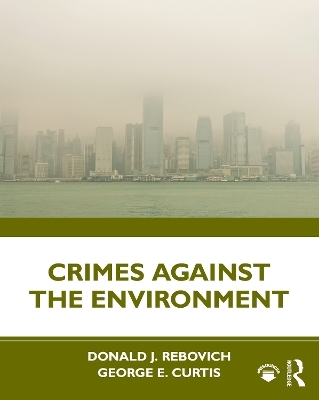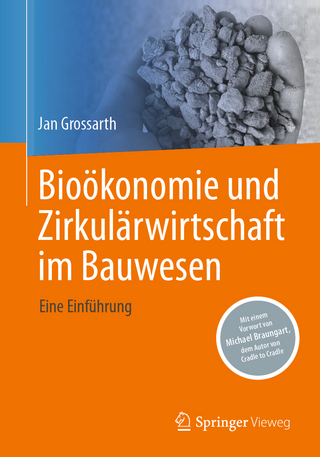
Crimes Against the Environment
Routledge (Verlag)
978-1-4987-5486-6 (ISBN)
Crimes Against the Environment explains the seriousness of the threat posed by pollution, its roots, how it has evolved, how it differs across the planet, and how society has endeavored to create and enforce laws directed at its control.
Rebovich and Curtis begin with an overview of hazardous waste, the industries that produce toxins, available methods of waste treatment, and the legal environment of environmental crime. They examine the forces driving criminal behavior and the methods offenders adopt, as well as protections against polluters and their effectiveness. The book concludes with an examination of environmental justice in the United States and globally, and looks ahead to the future of crime control and prevention in this arena. Case studies and discussion questions offer further perspective on these challenging issues of environmental integrity.
This text serves undergraduate or early-stage graduate students majoring in criminal justice, environmental science, sociology, and political science, and could also serve as a resource for professionals in environment-related occupations.
Donald J. Rebovich, Ph.D., Distinguished Professor of Criminal Justice at Utica College, Utica, N.Y., is the Director of Financial Crime Programs at the College. Dr. Rebovich is also the Executive Director of the Center for Identity Management and Information Protection (CIMIP) of Utica College. Prior to Utica College, Dr. Rebovich served as the Research Director for the National White Collar Crime Center (NW3C) and the National District Attorneys Association (NDAA). At NW3C he was responsible for directing the national analysis of Internet crime report data generated by the FBI’s Internet Fraud Complaint Center, and directing the National Public Survey on White Collar Crime program. He is co-author of "Identity Fraud Trends and Patterns: Building a Data-Based Foundation for Proactive Enforcement," a national study of U.S. Secret Service identity theft cases covering a six-year period. He is also the author of Dangerous Ground: The World of Hazardous Waste Crime, which presented the results of the first empirical study of environmental crime and its control in the United States. Most recently, he co-edited a text entitled The New Technology of Crime, Law and Social Control. His background includes research in identity crime characteristics, economic crime victimization, white collar crime prosecution, protected health information, human trafficking, and multijurisdictional task force development. George E. Curtis is Professor Emeritus of Criminal Justice at Utica College, Utica, N.Y. He previously served as the Dean of the School of Business and Justice Studies, Executive Director of the Economic Crime Institute of Utica College, and as Director of Economic Crime Programs at the College. He received a Bachelor of Arts degree from Syracuse University in 1964 and a Juris Doctor degree from Brooklyn Law School in 1967. He is an attorney admitted to the Bar of the State of New York. Curtis served as a confidential law clerk in the New York court system for more than 26 years and is a former President of his local bar association and a former delegate to the New York State Bar Association’s House of Delegates. Professor Curtis is the author of The Law of Cybercrimes and Their Investigation, which was published in August 2011 by CRC Press, and is a co-author, with R. Bruce McBride, of a college text on Proactive Security Administration, published by Pearson Prentice Hall. Professor Curtis currently teaches undergraduate law-related courses in economic crime and cybercrime.
Introduction; 1. Hazardous Waste: What Is It and Why Is It a Threat?; 2. What Industries Produce Hazardous Waste and What Wastes Do They Produce?; 3. The Legitimate Treatment of Hazardous Waste in the United States: What Was Done in the Past and What Is Done Today; 4.The Legal Environment of Environmental Crime; 5. The Driving Forces of Environmental Criminality; 6. Criminial Methods of Today’s Average Environmental Offender; 7. Who Protects Us From Environmental Crime and How Effective Are They?; 8. Justice for All? Are We Achieving Environmental Justice in the United States?; 9. Environmental Crime Around the World; 10. Addressing Environmental Issues for the Future.
| Erscheinungsdatum | 24.05.2016 |
|---|---|
| Zusatzinfo | 13 Halftones, black and white |
| Verlagsort | New York |
| Sprache | englisch |
| Maße | 187 x 235 mm |
| Gewicht | 249 g |
| Themenwelt | Naturwissenschaften ► Biologie ► Ökologie / Naturschutz |
| Recht / Steuern ► EU / Internationales Recht | |
| Recht / Steuern ► Öffentliches Recht ► Umweltrecht | |
| Recht / Steuern ► Strafrecht ► Kriminologie | |
| Technik ► Umwelttechnik / Biotechnologie | |
| ISBN-10 | 1-4987-5486-4 / 1498754864 |
| ISBN-13 | 978-1-4987-5486-6 / 9781498754866 |
| Zustand | Neuware |
| Haben Sie eine Frage zum Produkt? |
aus dem Bereich


